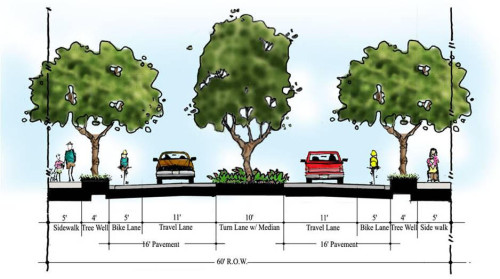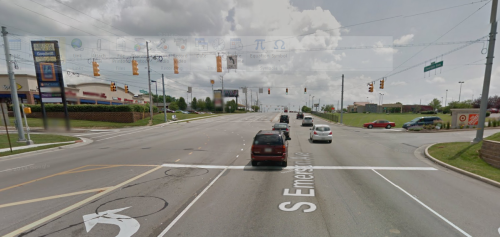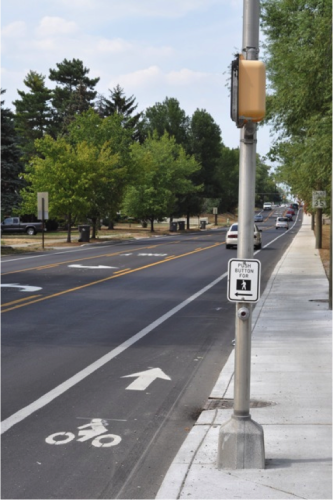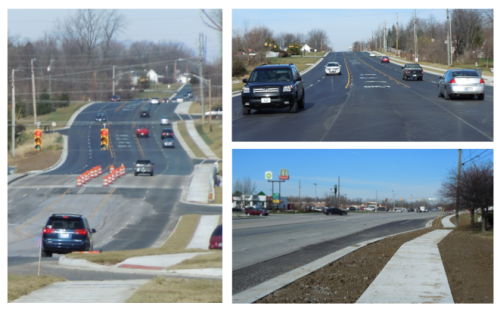Three years ago this summer, the City-County Council passed a Complete Streets ordinance in a unanimous vote, joining hundreds of cities nationwide that chose to commit to accessibility for all modes and abilities in their transportation planning. Shortly afterwards, Smart Growth America’s National Complete Streets Coalition recognized Indianapolis’ ordinance as the top Complete Streets ordinance out of nearly 130 policies adopted nationwide that year. The city has committed to this policy, but how has it been playing out in the implementation stage? Are the improvements on the ground living up to the praise our policy was awarded?
In a recent presentation at The Hall, the DPW shared some early results. The presentation highlighted two of the shining stars of Indianapolis’ recent development: the Cultural Trail and Georgia Street between the Convention Center and Banker’s Life Fieldhouse. While these projects are admirable examples of complete streets, they were already done (or nearly done) prior to the ordinance being passed. They’re also limited to downtown and the adjacent neighborhoods. So how does more recent development in other areas of town stack up?
Arlington Avenue
The Arlington Avenue project took the street down from four lanes to two with the addition of dedicated bike lanes, and included sidewalk repair and improvements. However, why was a tree lawn not placed between the sidewalk and the street to provide for separation between cars and pedestrians?
The right of way for Arlington Avenue appears to be about 70′ in this screenshot from MapIndy, with about 5′ to the east of the sidewalk on the east side of the street. With this extra space the sidewalk could have been placed 5′ further east to allow for a tree lawn to separate the sidewalk from the street.
For comparison, BikeStyle Spokane has a great example of a complete street done in only 60′ right of way, with tree lawns to boot. If this could be done with 10′ less ROW, why couldn’t it be done on the Arlington Avenue project? With the 10 additional feet on Arlington, the sidewalks could have even been made wider or bike lane separators could have been added.

A complete street with tree wells done with 10′ less ROW than the Arlington project. Photo: Bikestyle Spokane
Emerson Avenue
The Emerson Avenue project between Shelbyville Road and I-65 brought a sidewalk to the east side of the road where there previously was no sidewalk, and in this case a strip of grass if not a tree well was added to separate the sidewalk.
However, sidewalks are still lacking on the west side of the street. Furthermore, at the intersections where major businesses like Target, Aldi, and Home Depot are located on both the east and west sides of Emerson, there is no crosswalk to go from east to west. The intersection at Emerson and Southport Road, where more businesses are located on both sides of the street, also lacks an east-west pedestrian crosswalk.

A crosswalk takes pedestrians from north to south on Emerson but not from east to west, making the route between major businesses on both sides of Emerson more difficult and unsafe for pedestrians. Photo: Google Maps (click photo for link to interactive street view)
The project document from DPW notes that traffic along this corridor has increased by 600% in two decades, and the project’s increase from two lanes for automobile traffic to five makes this a priority. In fact, the summary of the benefits listed in the document does not even include benefits for pedestrians or bikers; instead highlighting “reduced traffic congestion and better driving conditions” in addition to a longer life for the roadway.
According to Smart Growth America, Complete Streets do take into account context in their planning (a Cultural Trail type development certainly might not be appropriate for this commercial corridor with heavy automobile traffic). However, Smart Growth America’s own definition of a complete street includes the stipulation that they “make it easy to cross the street, walk to shops…” A sidewalk on one side of a major auto thoroughfare without a safe way to cross the street or a safe destination for pedestrians once they reach the other side really does not a complete street make.
…
To their credit, Smart Growth America was clear on the point that a Complete Streets policy isn’t a mandate that everything be overhauled immediately, nor is it a prescription for a one size fits all design. However, these projects which were highlighted at the presentation appear to have given the majority of attention to detail to the design of the automobile component of the projects and left the pedestrian infrastructure as somewhat of an afterthought. Considering our policy was recognized nationally for the quality of its standards, I was hoping for a stronger showing of pedestrian and cyclist options in the projects to date.
Thanks to Chris Corr who contributed research and analysis regarding the Arlington Avenue ROW and design.























